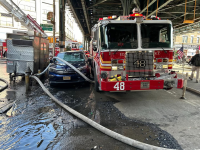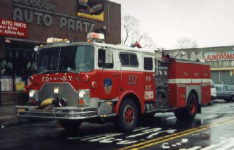TIPS FROM TRAINING 39 / 2025....
FDNY units in the Bronx recently encountered a hydrant with a damaged outlet during an all-hands fire (first photo above). The hydrant had damage to the threads on the 2.5” outlet; the cap would not screw onto this outlet. The ECC quickly remedied the situation by using a rubber hydrant plug (second photo above) to block the damaged outlet. A sufficient water supply was obtained. There are types of hydrants where a rubber hydrant plug cannot be used. Consider the following points.
• Prior to attempting to plug a hydrant, examine the inside of the hydrant to check for the presence of a large fitting near the top of the stem (third photo above).
• These types of large fittings have been encountered on several hydrants, they will prevent a hydrant plug from passing through.
• Do not attempt to use the rubber hydrant plug on hydrants with large fittings - use the steel hydrant plug instead (fourth photo above).
• If a damaged hydrant is encountered, consider first starting booster water and be sure to notify all members that there may be a delay in obtaining water from a hydrant. When hydrant water is obtained be sure to make a HT transmission.
• Use routine runs to check damage to hydrants. This hydrant was in an area where road construction was taking place; it can be assumed that damage was caused by construction activity – pay particular attention to hydrants located in these areas.
• Consider plugging a hydrant with a rubber hydrant plug and a steel hydrant plug during Multi Unit Drill.
#39 2025 – 5/7/2025
Disclaimer: Tips are created by the FDNY. Follow Your Departments Guidelines.
.............................................................................................
See paragraph 2.2 for photos.
www.nyc.gov/html/fdny/insider/resources/do/2025/058_2025_eoe.pdf








